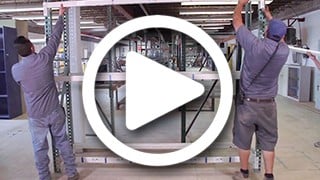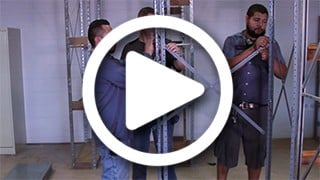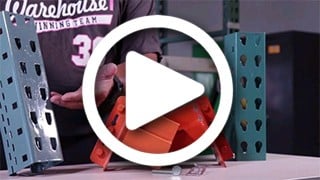Maximizing Vertical Warehouse Storage Systems for Space Utilization
 The ultimate goal of modern warehousing is to do more with less. In recent years, this has primarily been achieved through the strategic use of tech-forward solutions, including automated systems that expedite picking and packing.
The ultimate goal of modern warehousing is to do more with less. In recent years, this has primarily been achieved through the strategic use of tech-forward solutions, including automated systems that expedite picking and packing.
Sometimes, however, the most impactful solutions are not entirely tech-driven. The ultimate example? Vertical warehousing, which promises to reframe an issue that has plagued warehouses and distribution centers for decades: the constant need for more space.
Vertical storage brings a three-dimensional approach to material handling, revealing how facilities can be optimized to make the most of seemingly limited space. This mindset shift can have a powerful impact on every aspect of inventory management, influencing everything from productivity and accuracy to worker safety.
Vertical warehousing is the future, so this is the perfect time to implement vertical solutions and gain an edge. Keep reading to discover the value of vertical warehousing, along with creative opportunities for making the most of vertical space.
What Is Vertical Storage?
At first glance, the concept of vertical storage seems simple: products stored within a warehouse can be placed on shelves, racks, or other types of levels, rather than automatically situated near the floor. If strategic mechanisms are incorporated to promote easy retrieval, these items can be safely and quickly accessed even if they are kept at considerable heights.
This differs from traditional warehouse storage systems, in which, as more inventory is added, the initial impulse is to expand square footage and focus on horizontal storage solutions. Vertical warehousing aims to find innovative ways to store and access items without calling for sprawling, difficult-to-navigate facilities.
Advantages of Vertical Warehousing
The term 'vertical warehousing' is not limited to any one device or layout, but rather references the general priority of optimizing vertical space. There are many reasons to adopt a vertical warehousing mindset, including:
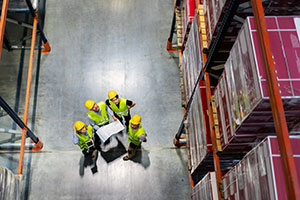 Space utilization. This is one of the most commonly cited benefits of vertical warehousing. Simply put, vertical space is often underutilized. Whether or not this space is taken advantage of, however, it must be paid for and maintained. Why not actually use the space and, in doing so, increase the facility's return on investment?
Space utilization. This is one of the most commonly cited benefits of vertical warehousing. Simply put, vertical space is often underutilized. Whether or not this space is taken advantage of, however, it must be paid for and maintained. Why not actually use the space and, in doing so, increase the facility's return on investment?- Increased storage density. High-density operations are increasingly prioritized given current supply chain demands and other challenges — but when high density is a priority, enterprises simply cannot afford to rely on horizontal space alone. If vertical warehousing solutions are implemented, more items can be stored without expanding the facility's footprint. Many of the solutions discussed below allow for impressive storage density without compromising ease of access or the general flow of the warehouse.
- Reduction in picking errors. Vertical systems can limit picking errors by drawing on the power of automated solutions. Beyond this, the sheer strategy involved in implementing a vertical setup can promote a better-organized layout, in which confusion is less likely and workers find it easier to locate the right items at the right time. The result? Dramatic improvement in order picking accuracy, even as picking becomes more efficient.
- Better safety and ergonomics. While vertical warehousing often utilizes automated solutions to great effect, this can promote worker health and safety even when it primarily relies on manual systems. After all, vertical storage allows warehouses to maintain a smaller footprint, and, as a result, workers do not need to travel nearly as far when picking and packing. Meanwhile, these systems are typically equipped with clever solutions that limit the need for repetitive reaching or bending.
- Enhanced inventory management. The qualities highlighted above coalesce to provide enhanced inventory control. With higher density comes an improved ability to maintain appropriate stock levels, thereby limiting the potential for stockouts. Furthermore, vertically optimized warehouses are, by nature, more scalable, so demand fluctuations and other changes can easily be accommodated without compromising inventory management.
Manual Vertical Warehouse Storage Systems
Forming the backbone of the warehouse and bringing structure to inventory management, manual storage systems consist of shelving solutions and tangible spaces that allow warehouse workers to navigate facilities with ease. These may look a bit different from one facility to the next, but they can be adapted to meet unique needs for storing and retrieving specific types of items. In general, the components of these systems include:
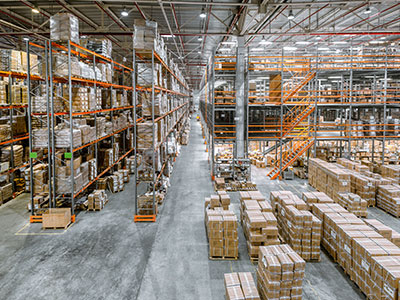 Pallet racks. As effective material handling systems, pallet racks align items in horizontal rows while also allowing for multiple levels arranged vertically. With high pile storage, pallet rack heights can exceed twelve feet, although this approach may call for adapted forklift solutions and advanced sprinkler systems.
Pallet racks. As effective material handling systems, pallet racks align items in horizontal rows while also allowing for multiple levels arranged vertically. With high pile storage, pallet rack heights can exceed twelve feet, although this approach may call for adapted forklift solutions and advanced sprinkler systems.- Shelving. Pallet racks contain multiple levels of shelves, on which materials are placed. Within the warehouse environment, however, the term 'shelving' actually refers to solutions for storing and organizing hand-packed items. Versatile metal and boltless solutions can accommodate a variety of materials, while storage bin shelving relies on plastic bins or dividers.
- Mezzanines. Versatile structures known as mezzanines can form intermediate levels between the floor and the ceiling of the warehouse. These structures can greatly expand workspace without requiring additional square footage. They are economical, flexible, and surprisingly easy to assemble.
- Flow racks. Relying on a slight slope to facilitate movement, flow racks provide a manual approach to improving warehouse efficiency. Under this approach, products are not only stored in multiple tiers but also retrieved from those levels with minimal effort.
Automated Vertical Warehouse Storage Systems
The physical structures highlighted above form the basis of well-organized, efficient, and high-density storage solutions. Increasingly, however, many facilities also rely on automated systems to maximize limited space while also delivering impressive improvements in warehouse productivity.
We have highlighted a few of the most promising automated opportunities below, along with details about how they can be implemented to leverage vertical space.
Automated Storage and Retrieval Systems
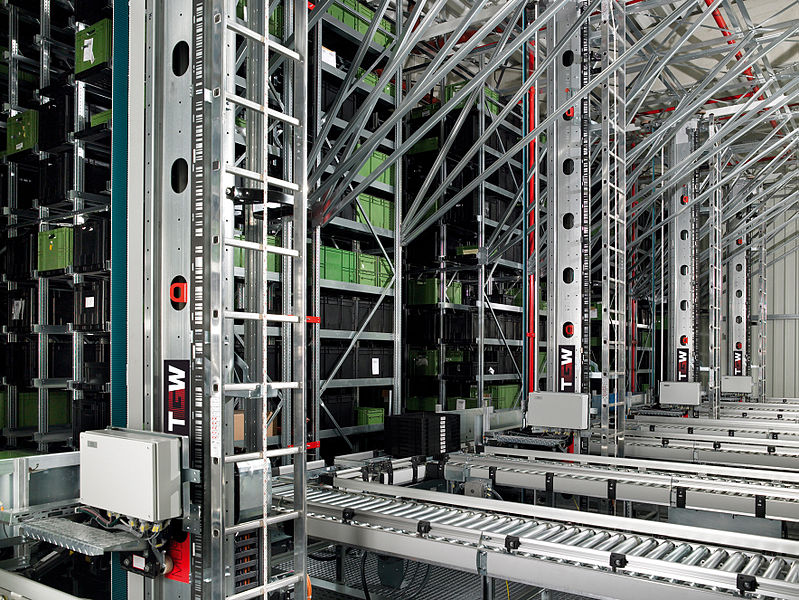 Automated storage and retrieval systems (AS/RS) are computer-assisted solutions designed to shelve or find specific items without the need for manual picking. These systems often draw on several technologies and devices to provide a tailored approach. Many of the automated strategies we'll discuss below actually fall into the overarching category of AS/RS, as do these common solutions:
Automated storage and retrieval systems (AS/RS) are computer-assisted solutions designed to shelve or find specific items without the need for manual picking. These systems often draw on several technologies and devices to provide a tailored approach. Many of the automated strategies we'll discuss below actually fall into the overarching category of AS/RS, as do these common solutions:
No matter which elements they incorporate, AS/RS emphasizes one main goal: to expedite picking. Done right, AS/RS can also boost picking accuracy and even worker safety.
Vertical Carousels
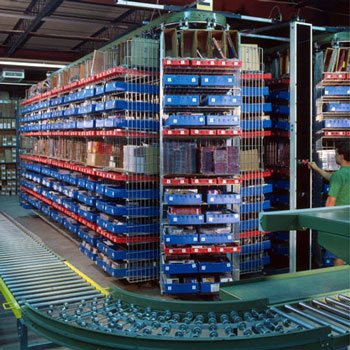 Forming a strategic loop, vertical carousels function a lot like Ferris wheels — but precisely stored products replace human passengers. This is a highly ergonomic setup, as carousel operators can easily select the specific items they want to retrieve while letting the carousel bring those products to the most practical height. The result? Less bending and reaching.
Forming a strategic loop, vertical carousels function a lot like Ferris wheels — but precisely stored products replace human passengers. This is a highly ergonomic setup, as carousel operators can easily select the specific items they want to retrieve while letting the carousel bring those products to the most practical height. The result? Less bending and reaching.
Another advantage: vertical carousels help to maintain a minimal warehouse footprint. These high-density systems are uniquely versatile and can be implemented in a variety of facilities to make the most of every available square foot. Their vertical orientation allows them to overcome many of the space-related concerns associated with horizontal carousel systems.
Commonly utilized for storing electronic components, medical supplies and other items that may need to be hand-picked, vertical carousels may also be utilized in the automotive industry or for some eCommerce operations.
Vertical Lift Modules
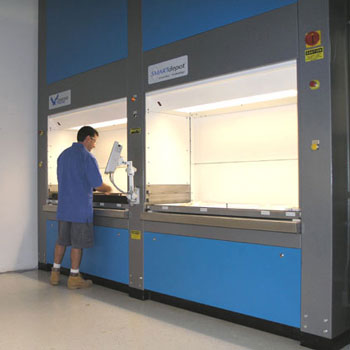 Similar in many respects to vertical carousels, vertical lift modules (VLM) rely on stacks of trays to store a variety of items. These stacks form a column, with automated pickers finding and moving trays as needed. VLMs can be customized to feature various load capacities or even to provide dual tray delivery. These systems offer many unique advantages, including considerable space savings and a cutting-edge, data-driven approach to material handling.
Similar in many respects to vertical carousels, vertical lift modules (VLM) rely on stacks of trays to store a variety of items. These stacks form a column, with automated pickers finding and moving trays as needed. VLMs can be customized to feature various load capacities or even to provide dual tray delivery. These systems offer many unique advantages, including considerable space savings and a cutting-edge, data-driven approach to material handling.
VLMs are more technologically advanced than vertical carousels, and, while carousel systems are often compared to Ferris wheels, VLMs more closely resemble vending machines. With VLMs, there is no need to rotate other inventory upon requesting a specific item. VLMs may require twice as much depth as vertical carousels, however, so, depending on specifications, carousels may sometimes be the better option for space utilization purposes.
The versatile and efficient nature of VLMs can make them valuable for eCommerce although in general these systems are preferable for applications emphasizing small to midsize items.
Conveyor Systems
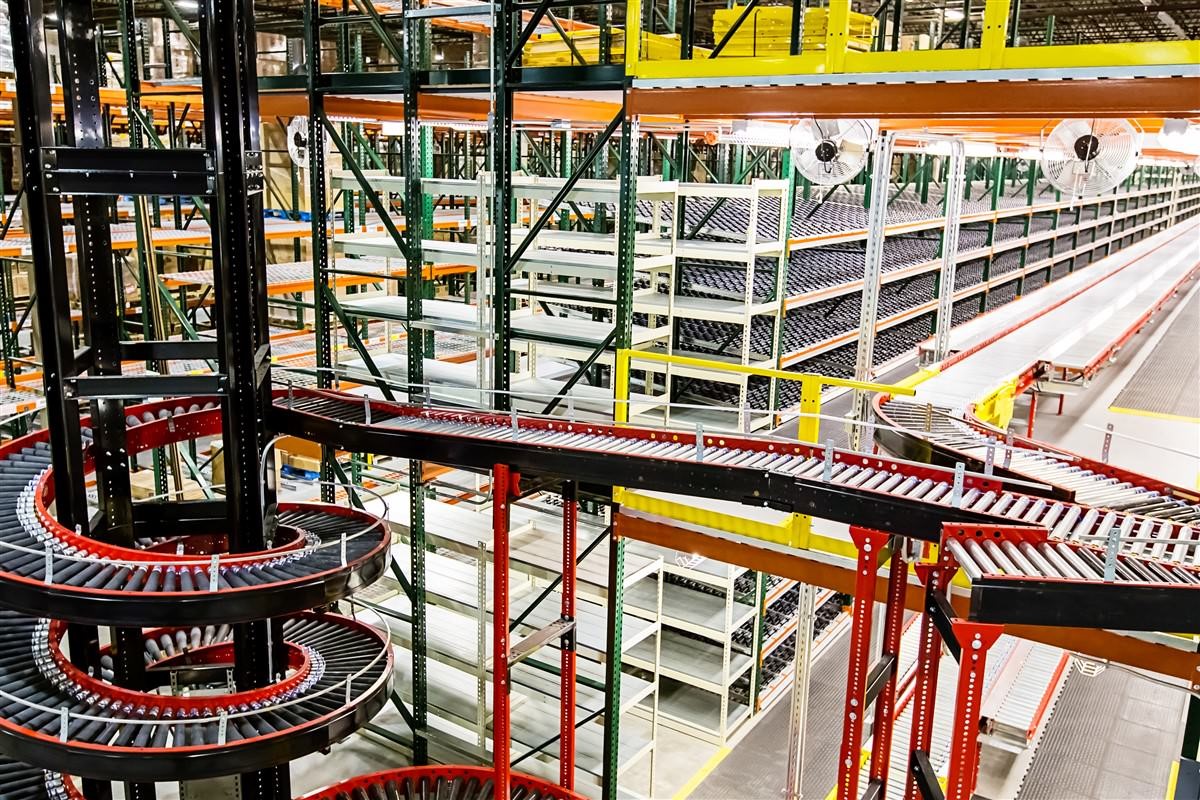 Designed to seamlessly move items from one area of the warehouse to the next, conveyor systems take many forms. While these can be manually operated, automated solutions improve efficiency. These can even incorporate sortation solutions, which further enhance warehouse productivity. Common examples of warehouse conveyors include:
Designed to seamlessly move items from one area of the warehouse to the next, conveyor systems take many forms. While these can be manually operated, automated solutions improve efficiency. These can even incorporate sortation solutions, which further enhance warehouse productivity. Common examples of warehouse conveyors include:
- Incline conveyors
- Accumulation conveyors
- Sortation conveyors
- Pallet conveyors
- Live roller conveyors
- MDR conveyors
In general, conveyors rely on systems of pulleys, belts, and driven units. These maintain a continuous loop, with the speed of the system dependent on the types of products being moved and the type of route on which they need to travel.
While our standard perception of conveyors involves a horizontal orientation, these systems can also make the most of vertical space. Some vertical conveyors function a lot like elevators, allowing items to easily be lifted from one level to the next. Gravity conveyors also optimize vertical space, ensuring that items flow seamlessly between levels.
Conveyors are largely utilized in warehouses that call for high SKU volumes, especially when zone-based systems are required. These are heavily utilized in the food and beverage industries but may also prove valuable for manufacturing or even agricultural applications.
Integration with Warehouse Management Systems
 A variety of systems and solutions can promote vertical storage, but these must be selected in the context of the current warehouse management and enterprise resource planning (ERS) systems. All components must work together to promote the bigger picture: a functional and highly efficient warehouse. Nuanced equipment integration ensures that all warehousing solutions are properly utilized to promote a desirable ROI.
A variety of systems and solutions can promote vertical storage, but these must be selected in the context of the current warehouse management and enterprise resource planning (ERS) systems. All components must work together to promote the bigger picture: a functional and highly efficient warehouse. Nuanced equipment integration ensures that all warehousing solutions are properly utilized to promote a desirable ROI.
This process begins with carefully developing or updating an overarching warehouse strategy. In some situations, this may call for reconfiguration, as vertical solutions may not be viable within the scope of the current warehouse layout or structure. If, at the outset of the design process, vertical warehousing is cited as a priority, critical decisions regarding layout design and technology integration can be made in a way that accommodates vertical storage.
Considerations for Choosing the Right Solution
 With such a dizzying array of vertical options available, the real struggle involves selecting the right setup. A lot depends on the types of products stored, although space limitations, budget restraints, and labor concerns will also come into play. Factors worth examining include:
With such a dizzying array of vertical options available, the real struggle involves selecting the right setup. A lot depends on the types of products stored, although space limitations, budget restraints, and labor concerns will also come into play. Factors worth examining include:
- Specifications. As we've touched on, vertical systems can vary significantly in size and scope, and even solutions that are designed to optimize space may be too large for some facilities. Height must also be considered: not all warehouses can safely accommodate high pile storage.
- Efficiency. Many vertical systems are designed to boost efficiency but not all can guarantee a desirable throughput. This is often application-dependent, and slotting may have a huge influence on efficiency. Automated solutions such as VLMs promise to improve warehouse efficiency, however, and flow racks can also expedite the picking process.
- Product-specific concerns. Currently, vertical systems are largely developed with shelf-stable items in mind. Cold storage presents unique concerns related to power supply, and, while strategic solutions are available, retrofitting and reconfiguration will nearly always be necessary. Done right, however, this can limit manual work in cold — and therefore, harsh — warehouse environments. Similarly, bulky or oddly-shaped products may be more difficult to accommodate, although some heavy-duty cantilever systems are well-suited to vertically-oriented warehouse operations.
Partner with WH1 for Vertical Warehouse Storage
Vertical storage solutions promise to optimize space management while also boosting productivity, safety, and accuracy. There is no one way to leverage vertical space, but with today's top palletizing and AS/RS opportunities, customized solutions are well within reach.
At Warehouse1, we recognize the value of a curated warehouse design. This can encompass everything from optimized layouts to cutting-edge automated systems. We are happy to provide guidance and support as you select the tools and technologies that best accommodate your unique needs and preferences. Contact us today to learn more about our warehouse solutions.
